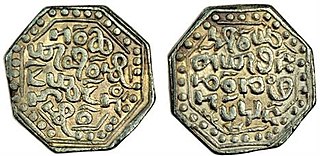
The Ahom dynasty (1228–1826) ruled the Ahom Kingdom in present-day Assam, India for nearly 598 years. The dynasty was established by Sukaphaa, a Shan prince of Mong Mao who came to Assam after crossing the Patkai mountains. The rule of this dynasty ended with the Burmese invasion of Assam and the subsequent annexation by the British East India Company following the Treaty of Yandabo in 1826.

There were three Burmese invasions of Assam between 1817 and 1826, during which time the Kingdom of Assam came under the control of Burma from 1821 to 1825. Locally, this period, called the manor din by the Indigenous Assamese people is remembered with horror. The sharp drop in population due both to depredations as well emigrations left the erstwhile kingdom in shambles. It was the climactic period of the Ahom kingdom. The British, who were earlier reluctant to colonise Assam, came into direct contact with a belligerent Burmese occupying force. Following the First Anglo-Burmese War they annexed Assam and took Manipur as a subsidiary state.

Suhungmung, or Dihingia Roja I was one of the most prominent Ahom Kings who ruled at the cusp of Assam's medieval history. His reign broke from the early Ahom rule and established a multi-ethnic polity in his kingdom. Under him the Ahom Kingdom expanded greatly for the first time since Sukaphaa, at the cost of the Chutia and the Dimasa kingdoms. He also successfully defended his kingdom against Muslim invasions, first by a general called Bar Ujjir and another by Turbak Khan. During his time, the Khen dynasty collapsed and the Koch dynasty ascended in the Kamata kingdom. His general, Ton-kham, pursued the Muslims up to the Karatoya river, the western boundary of the erstwhile Kamarupa Kingdom, the farthest west an Ahom military force had ventured in its entire six hundred years of rule.
Borgohain was the second of the two original counselors in the Ahom kingdom. He was selected by the Ahom king from members of the Ahom nobility, who vowed not to fight for the position of Ahom kingship, rather act as a guide to the Ahom king in matters of administering his province in an efficient manner .The other original counsellor is the Burhagohain. Both the positions existed from the time of the first Ahom king, Sukaphaa. After the first major expansion of the Ahom kingdom, the Sadiya province was initially given to the Borgohain to administer. But later in the year 1527, he was replaced by King-lun Buragohain who was made Thao-mung Bo-ngen. After that, he was given the region south of the Dikhou river to Kaliabor on the south bank. In later times, he administered the region east of Burai on the north bank, as Borbarua was given the charge of territories between Sadiya province to Kaliabor.

Sunenphaa also, Pramatta Singha, was the king of Ahom Kingdom. He succeeded his elder brother Swargadeo Siva Singha, as the king of Ahom Kingdom. His reign of seven years was peaceful and prosperous. He constructed numerous buildings and temples. The most famous of his buildings was the Rang Ghar, which is also considered as the oldest amphitheatre in Asia.

Suklingphaa, or Kamaleswar Singha, was a king of the Ahom kingdom. He came to power when he was a toddler, and died in his teens during a small pox epidemic. The de facto ruler during his reign was Purnanada Burhagohain, who was able to consolidate power after installing him on the throne; and his parents Kadamdighala and Numali also were very powerful. Kamaleswar Singha's reign witnessed the suppression of Moamoria rebellion and restoration of Ahom rule over Upper Assam. The Dundiya Revolution in Kamrup was also suppressed during his reign. In Nagaon, the Ahom army also managed to defeat a coalition of Moamoria rebels and the Kacharis of Kachari Kingdom. Much of this was the handiwork of Purnananda Burhagohain and not Kamaleshwar Singha.

Suklamphaa also Ramadhwaj Singha was a king of the Ahom kingdom. His reign is known for the rise in power of Debera Borbarua and the beginning of a ten-year period of power struggles among high officials of the kingdom that saw quick changes in kings via court intrigues and internal armed conflicts.

Sudingphaa also, Chandrakanta Singha, was a Tungkhungia king of the Ahom dynasty, who ruled at the climactic of the Ahom kingdom. His reign witnessed the invasion of Burmese on Assam and its subsequent occupation by British East India Company. He was installed as King twice. His first reign ended when Ruchinath Burhagohain deposed him and installed Purandar Singha in his stead. His second reign ended with his defeat at the hands of the invading Burmese army. He continued his militant efforts to regain his kingdom as well as to keep Purandar Singha at bay. Finally he submitted himself to Burmese who induced him to believe that they will make him king. Instead he was seized and placed in confinement at Rangpur. After the defeat of Burmese in the First Anglo-Burmese War and subsequent peace Treaty of Yandabo on 24 February 1826 CE, Assam passed into the hand of British. Most of the members of Ahom Royal family were granted pensions. Chandrakanta Singha received a pension of 500 rupees. He first lived in Kaliabor and later on at Guwahati. He visited Calcutta in order to request the restoration of his kingdom but in vain. He died in 1839 CE soon after his return to Guwahati.

Purandar Singha was the last king of the Ahom kingdom in Assam. He was installed as king twice. The first time, he was installed by Ruchinath Burhagohain in 1818 CE, after the latter deposed Chandrakanta Singha from the throne. His first reign ended in 1819 CE, during the second Burmese invasion of Assam, when his forces were defeated and the Burmese reinstalled Chandrakanta Singha on the throne. He along with Ruchinath Burhagohain continued their efforts to expel Burmese invaders, by seeking help from British and through armed struggle. After First Anglo-Burmese War, the British East India Company took over Assam from the Burmese invaders. Finding it difficult to administer an unfamiliar region and sensing discontent among the local inhabitants to foreign rule, the British authorities decided to restore Upper Assam to a prince of Ahom Dynasty. Purander Singha was found suitable for this post and therefore, in April 1833 CE, except for Sadiya and Matak rajya, the entire territory of Upper Assam was formally made over to him, on the condition of yearly tribute of 50,000 rupees. Later, in 1838 CE, finding him incompetent and a defaulter in payments of revenue, the British formally annexed his kingdom, putting an end to a 600 years reign of the Ahom dynasty. When Purandar Singha accepted the position of prince over upper Assam, he did not realize the difficulties of his new position.

Sudangphaa (1397–1407) was the king of the Ahom kingdom. He was popularly known as Bamuni Konwar because of his upbringing in a Brahman's house. His reign marks the first stage in the growth of Hinduism in the Ahom dynasty. He initiated the Singarigharutha ceremony of the Ahom kings, a tradition which was followed by his successors.

Tyao Khamti or Tao Khamthi was the king of Ahom kingdom from 1380 CE to 1387 CE. His accession to the throne put an end to the interregnum in Ahom kingdom, which lasted from 1376 CE to 1380 CE, after king Sutuphaa was treacherously murdered by Chutia king. But his weakness towards his elder queen and to her acts of atrocities towards common people, ultimately led to his own assassination, followed by another interregnum.

Suphakphaa was the king of Ahom kingdom from 1422 CE to 1439 CE. He was the son of the king Sujangphaa. Suphakphaa succeeded his father in 1422 CE and reigned for seventeen years. Nothing of any importance was recorded by Ahom chronicles about his reign. He died in 1439 CE and was succeeded by his son, Susenphaa.

Susenphaa was the king of Ahom kingdom from 1439 CE to 1488 CE. Contemporary Ahom chronicles described him as a good king and the people under him were happy and prosperous. He ruled for a long period of 49 years. The only trouble which was recorded during his reign was the raids of Tangsu Nagas, which was dealt with the use of force, but not without losses.

Suhenphaa was the king of Ahom kingdom from 1488 CE to 1493 CE. His reign was characterized by the expansion of Ahom kingdom which resulted in conflicts with the Nagas and with the Kachari kingdom. He was successful in the military actions against the Nagas, while in case of Kacharis, he suffered defeat and had to sue for peace with the Kacharis. He was assassinated by one Ahom of Tairungban clan.

Supimphaa was the king of Ahom kingdom from 1493 CE to 1497 CE. In order to exact revenge on the murderers of his father Suhenphaa, he unleashed a reign of terror among people of both high and low ranks alike.

Suteuphaa was the second king of Ahom kingdom who ruled from 1268 CE to 1281 CE. Suteuphaa succeeded his father Sukaphaa, who laid the foundation of Ahom kingdom in Assam. His reign was characterized by the expansion of his father’s kingdom. He also had conflicts with the Shans or Naras of Mungkang, a Shan kingdom in Upper Burma.

Sukhrangpha or Tao Shukhampha was the king of Ahom kingdom from 1332 CE to 1364 CE. He had to face the revolt led by his youngest brother Chao Pulai or Tai Sulai (there are confusion in Ahom historians whether Chao Pulai and Tai Sulai were same or different personality. Eventually he came in terms with Chao Pulai by appointing him as Charing Raja, a newly created official post to administer the region of Charing. Later the post of Charing Raja was usually conferred to the heir apparent to the throne. It can be compared with the title of Prince of Wales of England, where the heir apparent to the throne was conferred with this title.

Sutuphaa was the king of Ahom kingdom from 1369 CE to 1376 CE after an interregnum, though historians differ regarding his year of accession, as some of them claim his year of accession was 1364. His reign was marked by conflicts with Chutia Kingdom, which later resulted in his treacherous murder, by the Chutias.

Jogeswar Singha was installed as the king of Ahom kingdom in 1821 CE, by the Burmese. He was more or less a puppet in the hands of the Burmese, who held the real power of administration. His reign witnessed Burmese atrocities on the people of Assam and the attempts made by Chandrakanta Singha and Purandar Singha to expel Burmese invaders. Historians dispute regarding the date of his deposition from the throne, as some historians claimed that he was deposed by his Burmese masters, after they secured complete victory over the forces of Chandrakanta Singha in 1822 CE, while some sources claimed that he remained as a puppet ruler till termination of Burmese rule in Assam by British East India Company, in 1825 CE, during First Anglo-Burmese War.

Sunyatphaa also Udayaditya Singha was the king of Ahom Kingdom from 1670 CE to 1672 CE. After his elder brother Swargadeo Chakradhwaj Singha died in the middle of Ahom-Mughal war, Udayaditya Singha succeeded to the throne. His reign witnessed the end of Ahom-Mughal war, which started during the reign of Chakradhwaj Singha, when the Mughal army led by Rajput prince, Ram Singh I of Amber, was decisively defeated by the Ahom forces led by Ahom commander Lachit Borphukan in the Battle of Saraighat. The later part of his reign was characterized by the failure of military expedition against the Dafala tribes and the influence of Paramananda Sannyasi, a saintly figure from Brindaban, over Udayaditya Singha. Udayaditya's over exerted devotion towards Paramananda Sanyasi, aroused dissatisfaction among the nobles, which ultimately caused his deposition and execution. His reign was followed by a series of political anarchy and internal disturbances in the Ahom kingdom which continued till the accession of Gadadhar Singha in 1681 CE.





